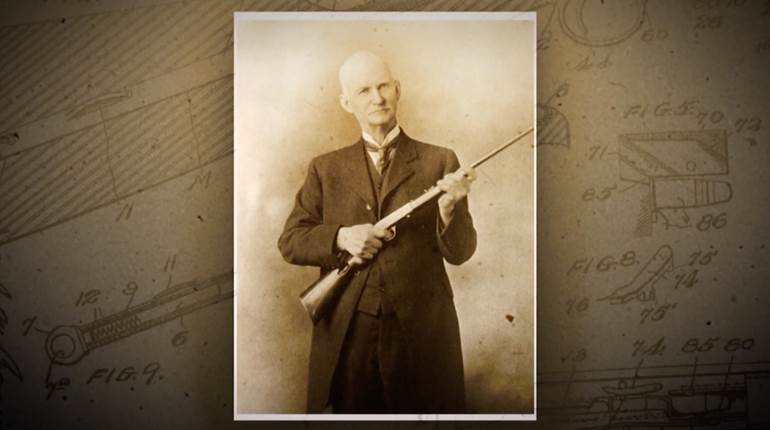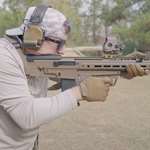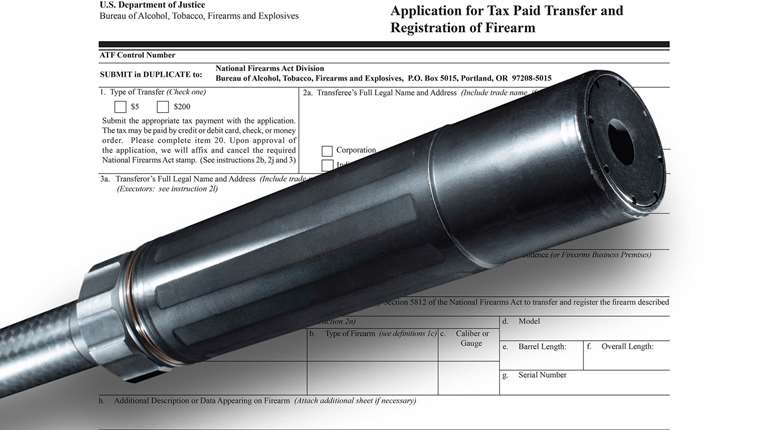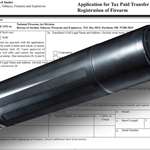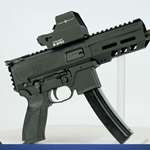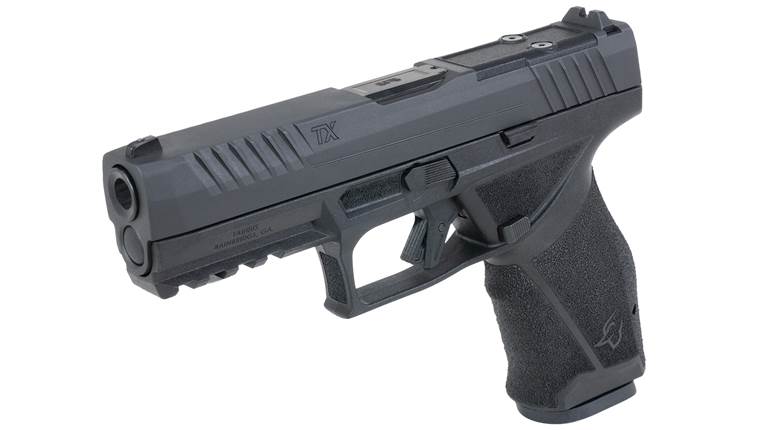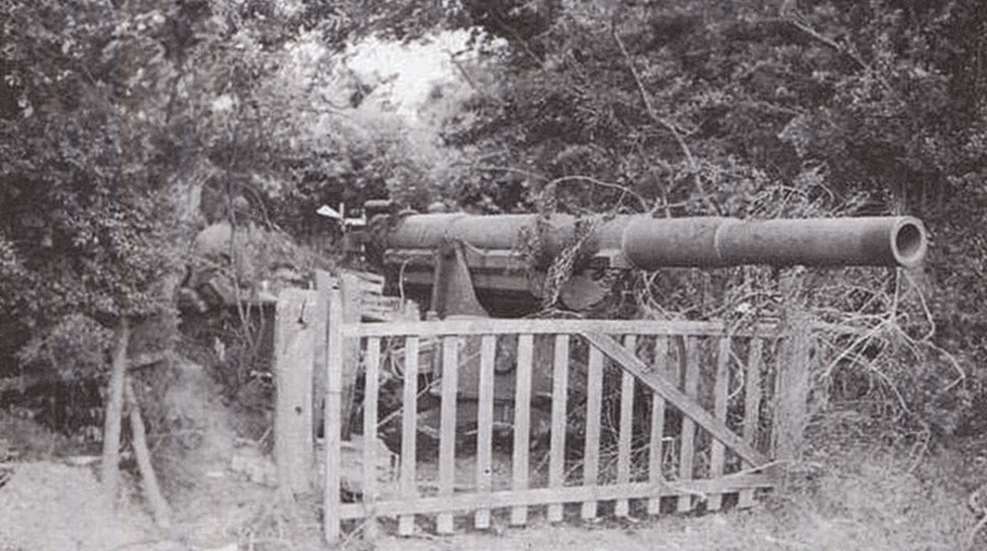
On D-Day, a force of 225 men from the U.S. Army’s 2nd Ranger Battalion was given the special mission of landing four miles west of Omaha Beach at a place called Pointe Du Hoc. After coming ashore, the Rangers would have to scale 100-ft. tall cliffs to conduct an assault against one of the most threatening German defensive positions in lower Normandy. 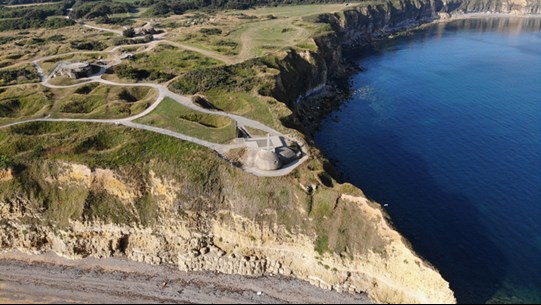
An aerial view of Pointe Du Hoc looking toward the battery’s R636a observation bunker with both H679 casemates visible in the background at upper left. (Photograph courtesy of Phil Marett/Jersey War Tours)
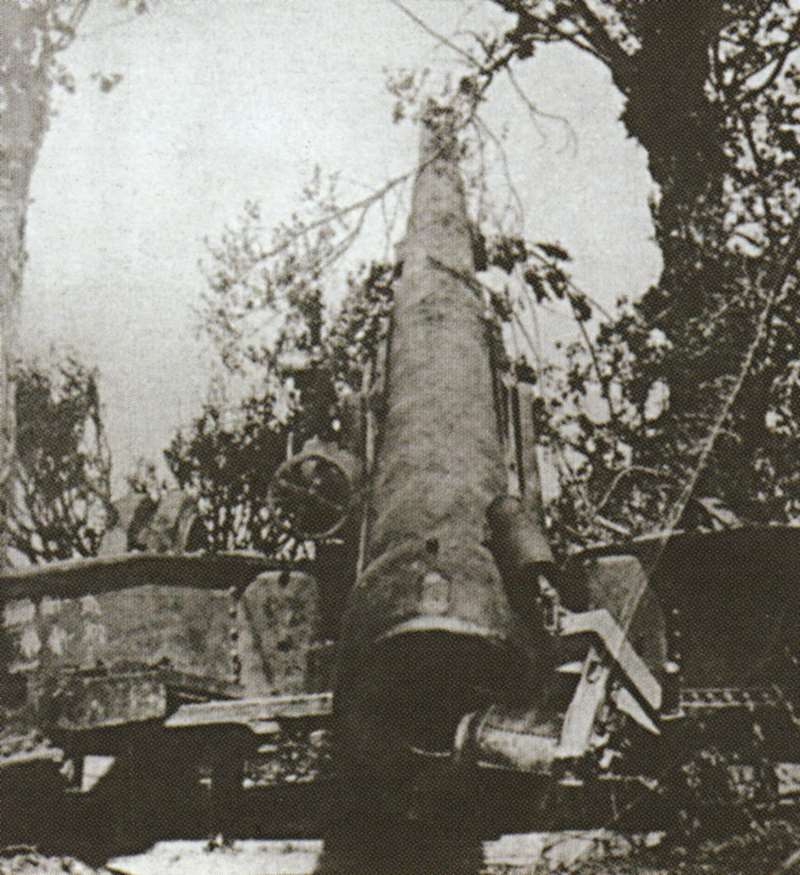
Established in May 1942, Heeres-Küsten-Batterie Pointe Du Hoc/Wiederstandsnest 75 (“Resistance Point number 75”) was a formidable German coast artillery battery armed with six French-made 155 mm breechloading rifles. Developed and adopted during the First World War, the French designated this type of gun Canon de 155 Grande Puissance Filloux (GPF) mle. 1917 and used it to good effect through to the Armistice of November 1918. With split trails, a tow-behind capability, a hydro-pneumatic recuperating system, and an effective range of over 10 miles, the GPF proved that it was a battlefield powerhouse on the Western front and, because of that, the piece remained in service during the interwar years. When the Germans invaded France in 1940, they captured more than 400 examples of the GPF and, recognizing the superlative quality of the gun, subsequently placed it in service under the designation 15.5 cm K.418(f). At Pointe Du Hoc, the guns were mounted on concrete traversing tables that enhanced their accuracy and transformed them into formidable anti-ship weapons. The Ranger mission on D-Day, which was commanded by Lt. Col. James Earl Rudder, had the objective of preventing those guns from firing on the fleet.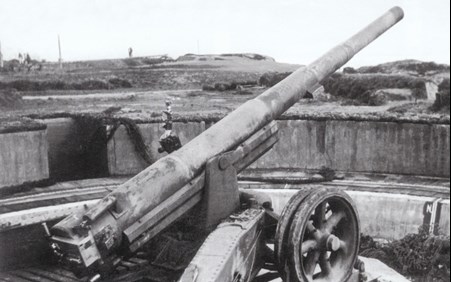
The six 15.5 cm K.418(f)s that armed Heeres-Küsten-Batterie Pointe Du Hoc were mounted on open concrete traversing tables that that enhanced their accuracy. Although it was a piece of field artillery, this mounting system transformed the GPF into an accurate and dangerous coast artillery weapon.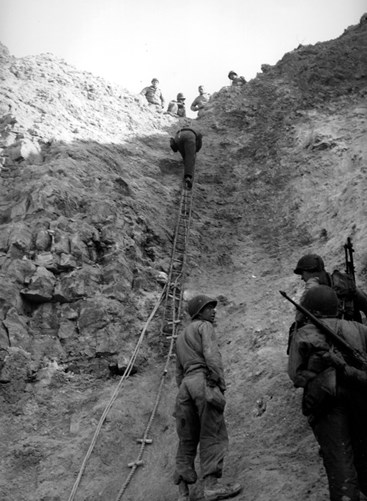
This may be the area where the Rangers who landed from LCA-888 managed to climb to the top by use of an extension ladder placed on a mound of rubble knocked out of the cliff face. Although this photo was taken on D +2 (June 8, 1944) when the route was being used for supplies, it nevertheless illustrates the location where most of the Rangers reached to top of the cliffs in the initial assault on D-Day. A toggle rope and two plain ropes are seen below the ladder. (Official U.S. Navy Photograph, now in the collections of the National Archives 80-G-45716)
At 7:10 a.m., Rudder’s force landed on the east side of the point from nine British made landing craft and began scaling the cliffs. The plan called for the Rangers to complete the climb using grappling hooks and ropes, but for most of them the ropes would not be necessary. When the Western Naval Task Force Fire Support Group bombarded Pointe Du Hoc earlier that morning, some of the rounds fell short and impacted the face of the cliff. The resulting explosions caused an avalanche that created a rubble pile on the beach that reached almost all the way to the top of the cliff. Most of the Rangers simply scrambled up that rubble pile, free climbed a runnel to the top the cliff, and then engaged the German troops holding the site—the men of 2./Heeres-Küsten-Artillerie-Regiment .1260 (the 2ndbattalion/Army Coast Artillery Regiment 1260).
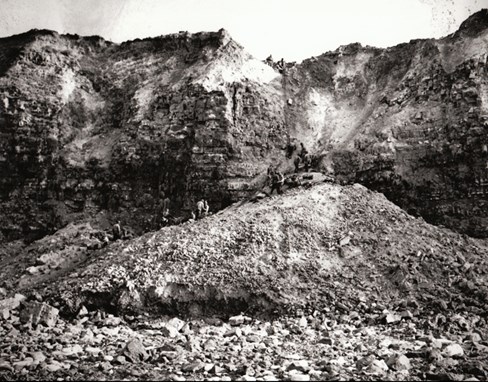
A view of the eastern side of Pointe du Hoc from the beach showing the spoil pile that was created when 14” shells from the battleship U.S.S.Texas (BB-35) struck the face of the cliff. (Official U.S. Navy Photograph, now in the collections of the National Archives 80-G-45718)
Following the climb, the Rangers brought the enemy under fire, and swiftly pushed them back from the battery area. That is when they discovered that no guns were mounted at the point. Instead, timbers had been placed on what was left of each of the six concrete traversing tables to present the false appearance that the battery remained armed. The Rangers also found two casemates for artillery at Pointe Du Hoc, but they were still under construction and their guns had not yet been mounted. In late April, the Germans had removed five of the K.418(f)s after a bombing raid heavily damaged the site. In an effort to conceal the guns from Allied aircraft, they were repositioned 1,200 meters to the south, but the Rangers did not know that at the time.
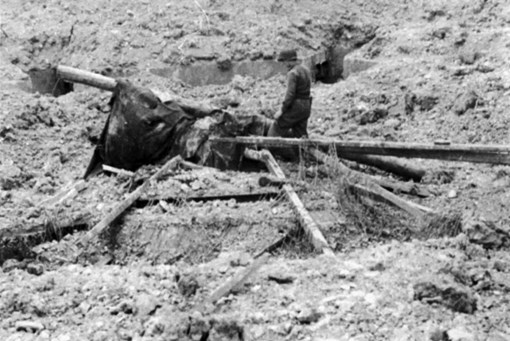
After the Germans soldiers of 2./Heeres-Küsten-Artillerie-Regiment .1260 (the 2ndbattalion/Army Coast Artillery Regiment 1260) removed the GPFs from Pointe Du Hoc during the night of April 25/26, 1944, they replaced them with timbers and wooden beams with the hope that they would give the impression that the battery remained armed. Here, Sgt. Warden F. Lowell inspects one of the dummy pieces on June 8, 1944.
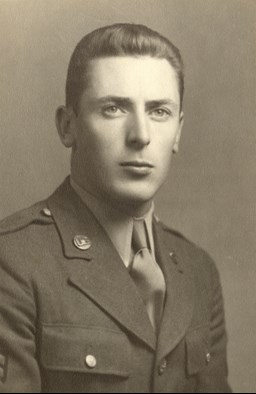 After securing the battery position at the point in a brief but intense firefight, they moved on to the next phase of their mission, which was to set up a roadblock on the Vierville/Grandcamp road. The purpose of the roadblock was to prevent German units from circulating from west to east in an effort to re-supply or reinforce the resistance points defending the cove that the Americans had code named Omaha Beach. Shortly after 8:00 a.m., D Company’s First Sergeant Leonard “Bud” Lomell was directing his men in setting up flank security for the roadblock when he noticed deep tire tracks in the mud of a hedgerow enclosed cattle path nearby. His instincts told him to follow the path so he did, and Lomell soon stumbled across the guns about 300 meters south of the road. He quickly returned to the roadblock, retrieved several Thermite grenades and then, with the assistance of another Ranger named Jack Kuhn, returned to the hedgerow where the guns were concealed. The thermite grenades were strategically placed on each gun’s traversing and elevation mechanisms where the intense heat they produced melted the gears and rendered them immovable. In this way, each gun was turned into a 28,660-lb. paperweight. After finishing with the Thermite grenades, Lomell used the buttstock of his Thompson submachine gun to smash the sights mounted on each piece. Although the mission had not unfolded precisely according to plan, the mission was nevertheless accomplished and the K.418(f)s never fired a shot against the Normandy invasion.
After securing the battery position at the point in a brief but intense firefight, they moved on to the next phase of their mission, which was to set up a roadblock on the Vierville/Grandcamp road. The purpose of the roadblock was to prevent German units from circulating from west to east in an effort to re-supply or reinforce the resistance points defending the cove that the Americans had code named Omaha Beach. Shortly after 8:00 a.m., D Company’s First Sergeant Leonard “Bud” Lomell was directing his men in setting up flank security for the roadblock when he noticed deep tire tracks in the mud of a hedgerow enclosed cattle path nearby. His instincts told him to follow the path so he did, and Lomell soon stumbled across the guns about 300 meters south of the road. He quickly returned to the roadblock, retrieved several Thermite grenades and then, with the assistance of another Ranger named Jack Kuhn, returned to the hedgerow where the guns were concealed. The thermite grenades were strategically placed on each gun’s traversing and elevation mechanisms where the intense heat they produced melted the gears and rendered them immovable. In this way, each gun was turned into a 28,660-lb. paperweight. After finishing with the Thermite grenades, Lomell used the buttstock of his Thompson submachine gun to smash the sights mounted on each piece. Although the mission had not unfolded precisely according to plan, the mission was nevertheless accomplished and the K.418(f)s never fired a shot against the Normandy invasion.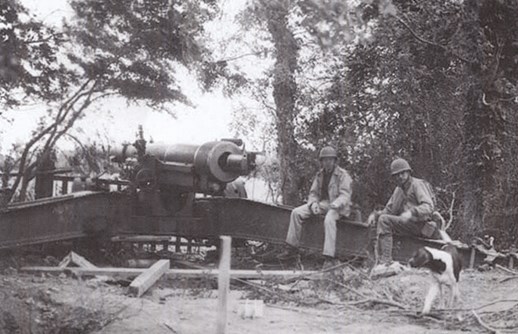
Two U.S. Army Rangers pose on the right split trail of the GPF seen in the photograph to the right of paragraph two. The wooden planks on the ground between the trails span a pit that has been excavated beneath the weapon’s breech to allow room for the gun tube to move through full recoil when firing at high elevation. Note that the weapon’s sight and breechblock are still in place.
Overnight on June 6/before dawn on June 7, the German 914th Grenadier Regiment launched two powerful counterattacks from the west that had the effect of pushing the Rangers all the way back to the point. But from his command post at Pointe Du Hoc’s eastern Type L409A anti-aircraft bunker, Lt. Col. Rudder was able to coordinate fire support from the Gleaves-class destroyer U.S.S. Satterlee (DD-626) offshore. An American flag was even placed on the face of the cliff near Col. Rudder’s command post so that the ship could detect the location of friendly forces. Accurate 5”/38-caliber fire from Satterlee’s four turrets held the enemy back and helped to secure a Ranger victory—albeit a costly one. By the time that infantry and armor from the 743rd Tank Battalion linked up with Rudder’s force at Pointe Du Hoc on June 8, the Rangers had suffered 135 casualties, mostly during the German counterattacks overnight on June 6.
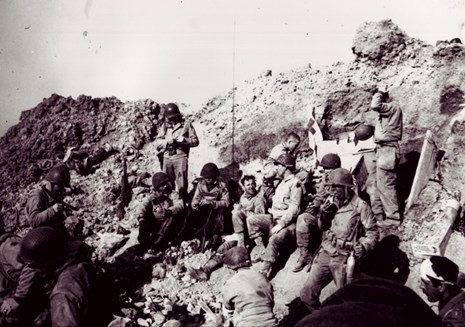
This photograph of Lt. Col. Rudder’s command post at Pointe Du Hoc’s eastern Type L409A anti-aircraft bunker was taken in the afternoon on D-Day, and it reveals the many purposes that a CP had to serve in combat: communications center, medical aid station, casualty collecting point, supply depot, etc. Perhaps the most intriguing thing about this photograph is the assortment of known individuals shown in it. The man with his head bandaged at bottom right is Lt. Col. Tom Trevor, a British commando who accompanied the Ranger assault force as an observer. The man to the left of the radio antennae loading a magazine for his M1 Carbine is Lt. Elmer H. “Dutch” Vermeer, 2ndRanger Battalion engineer officer. At far left an officer can be seen wearing a Canvas Assault Vest and a ring on his left ring finger. Although you cannot see his face, this person is none other than Lt. Col. James E. Rudder himself. (Official U.S. Navy Photograph, now in the collections of the National Archives 80-G-45721)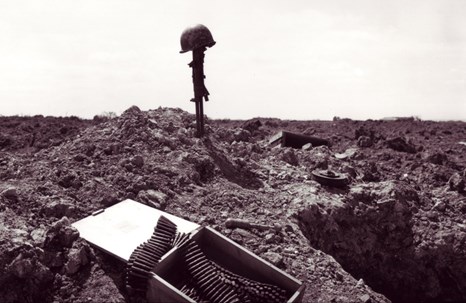
This memorial to a fallen soldier stands amid the craters and debris of battle at Stützpunkt Pointe Du Hoc/WN75. Here a U.S. M1 Helmet has been placed on top of the handgrip of a Vickers K Gun, the muzzle of which is stuck into the soil. Although a British machine gun chambered for the .303 British cartridge, K Gunswere used during the battle at Pointe Du Hoc mounted on the ends of extending ladders that were mounted on DUKWs. A belt of German 7.92x57 mm Mauser cartridges lies on a wooden crate in the foreground and a spent U.S. M22 Colored Smoke Rifle Grenade is just above it. The K Gun’s drum magazine is in the dirt at far right. (Official U.S. Navy Photograph, now in the collections of the National Archives 26-G-2441)
In the aftermath of the battle, one particular memorial to a fallen Ranger was raised amid the craters and debris at Pointe Du Hoc. A U.S. M1 helmet was placed on top of the handgrip of a Vickers K Gun, the muzzle of which was stuck into the soil. Although a British design chambered for the .303 British cartridge, K Guns were mounted on the ends of Merryweather Fire-Escape ladders that were, in turn, mounted on DUKW amphibious trucks. The original plan called for the DUKWs to swim up to the beach, then roll up to the base of the cliff at Pointe Du Hoc and extend their Merryweather ladders so that the K Guns could provide suppressing fire while the Rangers conducted their assault on the battery. Because of its blended hand grip/trigger and 60-round pan magazine, the K Gun was anatomically well suited for the mission in ways that the M1918A2 BAR (seen below) and the M1919A4 .30-cal. light machine gun were not. 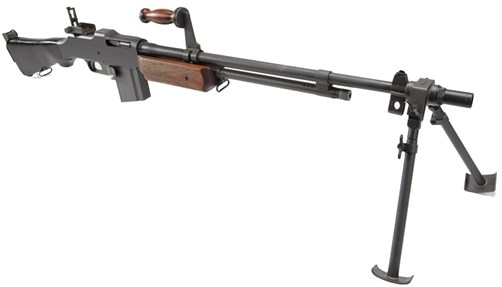
In addition to that, the K gun’s higher cyclic rate of fire of more than 1,000 rounds per minute made it a better choice for the job simply by virtue of the higher volume of fire it could produce. Since the Rangers would have nothing to mount the K Guns on as the battalion moved forward beyond the beachhead, they were not planning to use them after the morning of June 6. When the ammunition ran out, it would be all over and the K Guns were to be discarded as the battle pushed inland. Thus, the Pointe Du Hoc battle was not just fought by the M1 Garand rifle, the M1 Carbine, the BAR and the M1919A4 machine gun, but also an unconventional looking British aircraft machine gun that was called on to serve a very specific role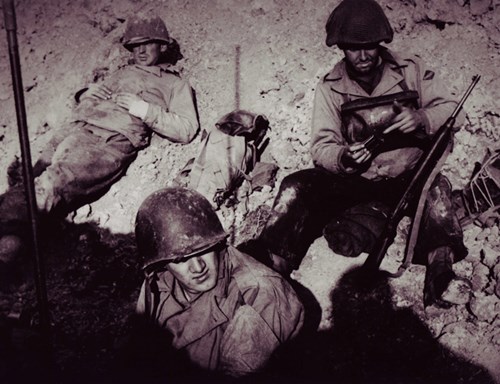
U.S. Army Rangers resting at Pointe du Hoc, which they assaulted in support of Omaha Beach landings on D-Day June 6, 1944. Note the Ranger at right is apparently using his middle finger to push a cartridge into an M1 Carbine 15-round magazine and that a Ranger lozenge/diamond patch is sewn onto the left shoulder of his M1941 Field Jacket. He is also still wearing an M5 Assault Gas Mask Bag. The Ranger in the center is operating a radio and is wearing a Poison Gas Detection Brassard over the left shoulder of his 1941 Jacket. These paper armbands were impregnated with a reactive paint that would turn pink or red if exposed to poison gas. (Official U.S. Navy Photograph, now in the collections of the National Archives 80-G-45715)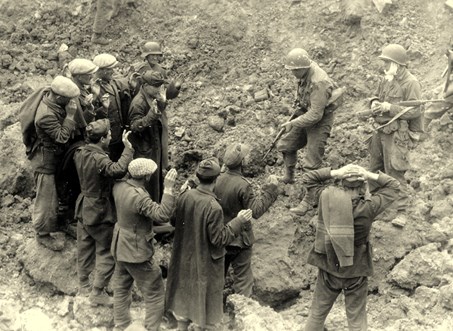
Here, two Rangers have captured three German soldiers along with three Italian and four French laborers from Organisation Todt, the Third Reich workforce responsible for civil and military engineering projects. The laborers were at Pointe Du Hoc to complete the two Type H679 casemates that were still under construction at the time of the invasion. LCVPs took 27 prisoners off of the point in the afternoon on June 7, including the 10 men seen here. (National Archives and Records Administration 111-SC-190268)
The Vickers K Gun was not the only obscure firearm associated with the battle at Pointe Du Hoc though. On the afternoon of June 7 the Rangers began sending prisoners down to the beach. While some of them were German soldiers, there were also Italian laborers from Organisation Todt who had been captured during the battle among the point’s craters. When those prisoners reached the beach, they were loaded aboard landing craft being used to evacuate the wounded out to the ships circling just off shore. Although they ultimately ended-up aboard an LST (Landing Ship, Tank), at first the prisoners were held aboard the New York-class battleship U.S.S. Texas (BB-35). With prisoners coming aboard, the ship’s Marine Detachment was called on to draw arms and guard them. 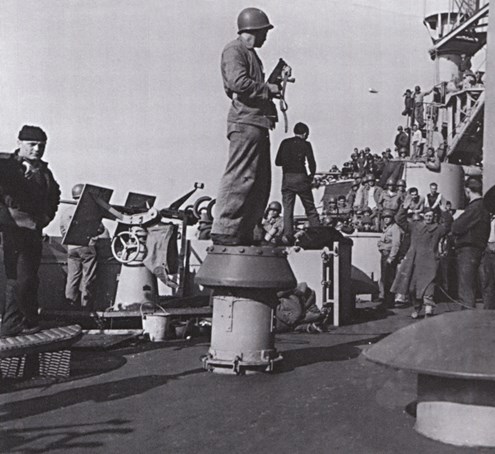
Another scene on the deck of the U.S.S.Texas showing prisoners from Pointe Du Hoc being brought aboard on D-Day. With dozens of the ship’s crew looking on, an Italian laborer comes forward under the watchful eye of a Marine armed with a .45-cal. Reising Model 55 submachine gun. The prisoners only remained on Texas briefly before being transferred to an LST.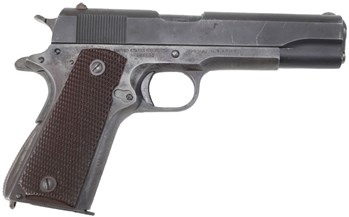 While Marine NCOs carried M1911A1 pistols (shown right), the guards themselves were armed with the Model 50 Reising submachine gun made by Harrington & Richardson. Although it may not be well known, U.S. Marines participated in the D-Day invasion, and many of them did so with the Reising. These men played an indirect role in an action that stood out among the many small battles that, in the aggregate, brought about the hard-fought victory of June 6, 1944. What these men did at Pointe Du Hoc on D-Day didn’t just secure the right flank of Omaha Beach and eliminate a dangerous coastal battery. They also established a legendary reputation for competence, courage and dedication to mission that remains well remembered to this day. Even after 75 years, visitors by the thousands come to the site every week to acknowledge how a small group of Americans changed the course of the war in Europe there on D-Day.
While Marine NCOs carried M1911A1 pistols (shown right), the guards themselves were armed with the Model 50 Reising submachine gun made by Harrington & Richardson. Although it may not be well known, U.S. Marines participated in the D-Day invasion, and many of them did so with the Reising. These men played an indirect role in an action that stood out among the many small battles that, in the aggregate, brought about the hard-fought victory of June 6, 1944. What these men did at Pointe Du Hoc on D-Day didn’t just secure the right flank of Omaha Beach and eliminate a dangerous coastal battery. They also established a legendary reputation for competence, courage and dedication to mission that remains well remembered to this day. Even after 75 years, visitors by the thousands come to the site every week to acknowledge how a small group of Americans changed the course of the war in Europe there on D-Day.












